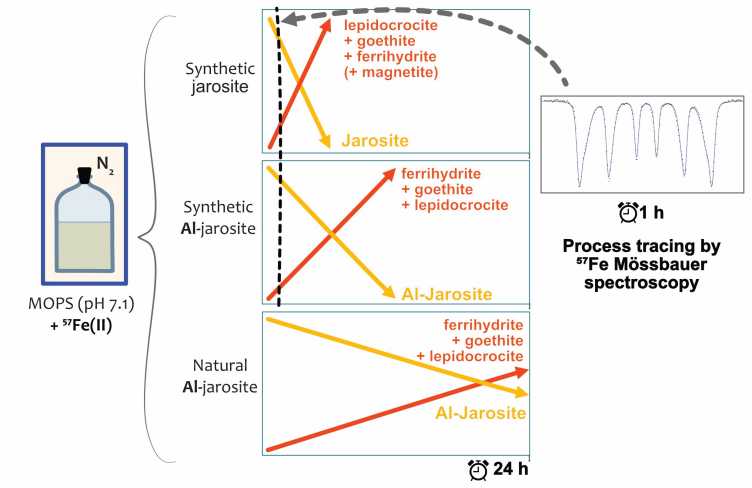New publication reveals how aluminium substitution affects jarosite transformation to iron oxyhydroxides in the presence of aqueous Fe(II)
The new publication in Geochimica et Cosmochimica Acta demonstrates how aluminium can slow the transformation of jarosite, and change the products of its transformation. Jarosite is commonly associated with acid sulfate soils, and the study sheds new light on the possible effect of Al in stabilising jarosite in flooded acid sulfate soils.

Jarosite is an abundant mineral in acidic environments, often found in acid sulfate soil (ASS) and acid-mine drainage (AMD). As a store of Fe, K, S and acidity, and a scavenger for major and trace elements, jarosite plays an important role in the biogeochemistry of acid sulfate environments. When ASS and AMD become anoxic, reducing conditions can set in, producing conditions that are outside the thermodynamic stability field of jarosite. In this study, we investigated the transformation of synthetic and natural jarosite with various degrees of Al-for-Fe substitution under circumneutral anoxic conditions in the presence of Fe(II), to understand the rates and pathways of jarosite and Al-jarosite transformation, the role of competing transformation pathways, the fate of Al during transformation and the different reactivity of natural and synthetic Al-jarosite. Synthetic jarosite (containing 0%–7% Al-for-Fe substitution) and a natural Al-substituted jarosite sample from an ASS in Thailand were suspended in solutions of 57Fe(II) at pH 7 for 24 h under anoxic conditions. The chosen experimental conditions mimic the Fe(II) concentrations and pH found in flooded ASS under reducing conditions. Changes in mineral composition of the suspensions were determined by Rietveld analysis of X-ray diffraction patterns at six time points. The fate of Al was determined by XRD, Raman spectroscopy and energy dispersive X-ray spectroscopy analysis of the jarosite and product minerals. Different transformation pathways that occurred simultaneously were traced by using 57Fe Mössbauer spectroscopy and aqueous Fe isotope composition. The analysis showed that 7% Al-for-Fe substitution in jarosite more than halved the mineral transformation rate compared to unsubstituted jarosite, regardless of the Fe(II) concentrations. Indeed, 7% Al-for-Fe substitution had a greater effect on the transformation rate than an order-of-magnitude decrease in the Fe(II) concentrations in all Al-for-Fe substitution treatments. The transformation products in all samples were goethite, lepidocrocite and ferrihydrite, with minor amounts of magnetite forming from jarosite with no or low Al-for-Fe substitution reacted with high Fe(II) concentrations. Lepidocrocite was the dominant product in reactors without aluminium, but lepidocrocite was not strongly enriched in 57Fe, suggesting that it may not have formed exclusively from Fe in solution during the Fe(II)-catalysed transformation of other minerals. In high-Al systems, lepidocrocite appeared to be a sink for Al, although its formation in Al-rich samples was suppressed. Natural jarosite reacted more than an order of magnitude more slowly than the synthetic jarosite and Al-jarosite, indicating that the properties of the synthetic jarosite do not completely account for the stability of natural jarosite under anoxic circumneutral conditions. The results provide an important baseline for understanding the drivers of jarosite transformation or stability in ASS and AMD.
